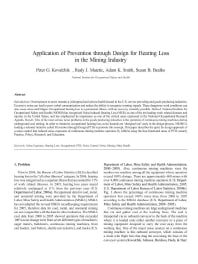Mining Publication: Application of Prevention through Design for Hearing Loss in the Mining Industry
Original creation date: February 2008
Authors: PG Kovalchik, RJ Matetic, AK Smith, SB Bealko
Overexposure to noise remains a widespread and serious health hazard in the U.S. service providing and goods producing industries. Excessive noise can lead to poor verbal communication and reduce the ability to recognize warning signals. These dangerous work conditions can also cause stress and fatigue. Occupational hearing loss is a permanent illness, with no recovery currently possible. National Institute for Occupational Safety and Health (NIOSH) has recognized Noise Induced Hearing Loss (NIHL) as one of the ten leading work-related diseases and injuries in the United States, and has emphasized its importance as one of the critical areas expressed in the National Occupational Research Agenda. One of the most serious noise problems in the goods producing industries is the operation of continuous mining machines during underground coal mining. In order to minimize occupational hearing loss, noise hazards are "designed out" early in the design process. NIOSH is leading a national initiative called Prevention through Design (PTD) to promote this concept. This paper describes the quiet-by-design approach of a noise control that reduced noise exposures of continuous mining machine operators by 3dB(A) using the four functional areas of PTD, namely Practice, Policy, Research, and Education.

- Assessment and Evaluation of Noise Controls on Roof Bolting Equipment and a Method for Predicting Sound Pressure Levels in Underground Coal Mining
- Development and Evaluation of a Urethane Jacketed Tail Roller for Continuous Mining Machines
- Equipment Noise and Worker Exposure in the Coal Mining Industry
- Hearing Loss in the Mining Industry: The Evolution of NIOSH and Bureau of Mines Hearing Loss Research
- Noise and Hearing Protection: Development of Two Training Exercises for Drillers
- Noise Source Identification on a Continuous Mining Machine
- Noise Source Identification on a Horizontal Vibrating Screen
- Technology News 539 - Identifying The Benefits Of Engineering Noise Controls Through A Business Case
- What Does a Hearing Loss Sound Like?
- Working in Noise with a Hearing Loss: Perceptions from Workers, Supervisors, and Hearing Conservation Program Managers